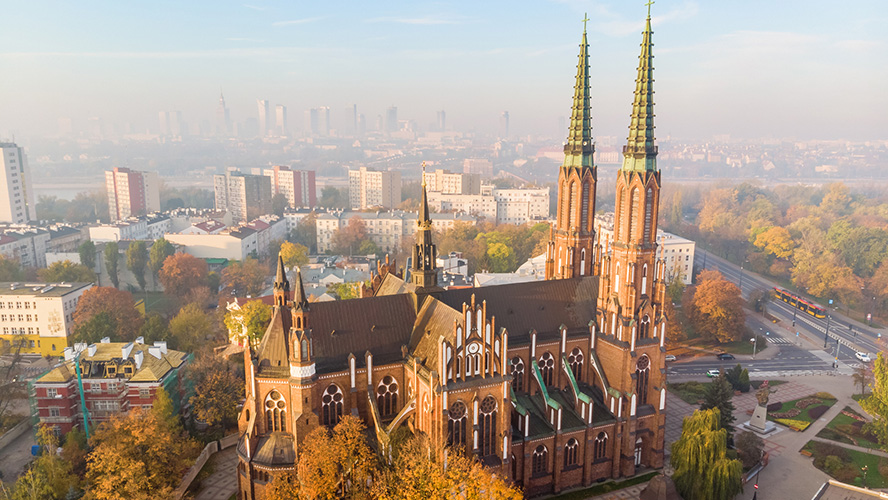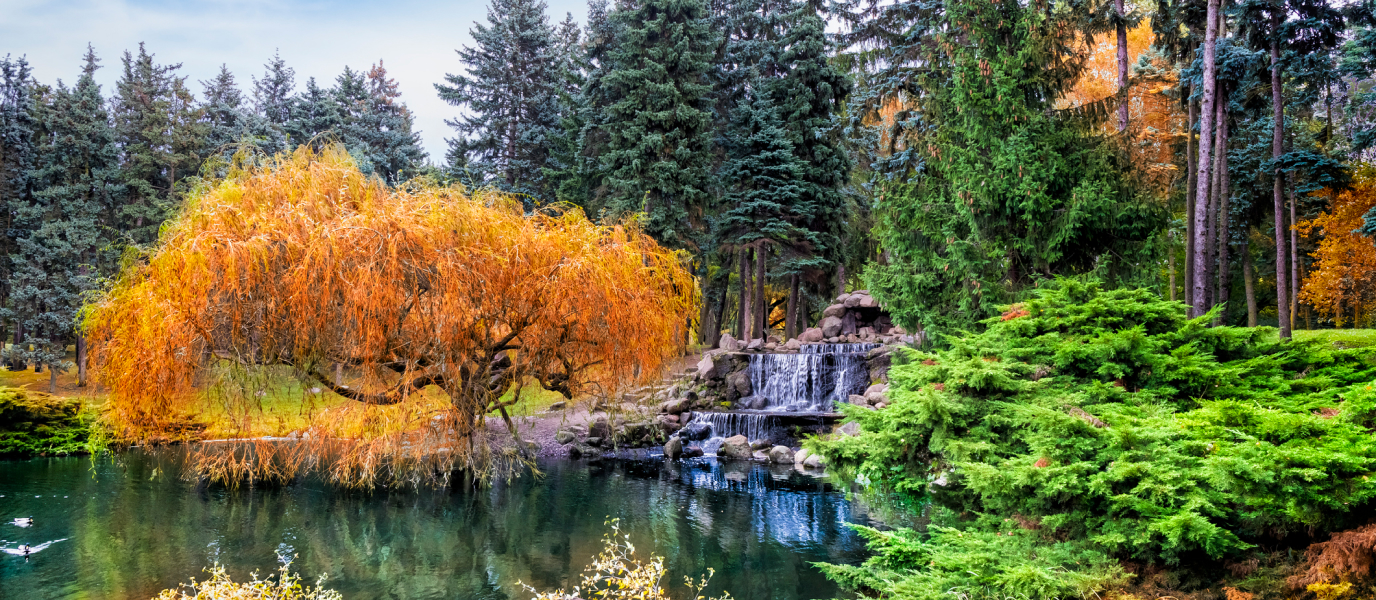Art galleries, cafés, restaurants, design shops, street art, etc. In this picturesque corner of Warsaw, the most avant-garde proposals combine with the old churches, former industrial facilities and residential blocks from the communist era, giving rise to a very appealing setting. The Praga district is clearly the most eclectic part of Warsaw.
As soon as you cross the Śląsko-Dąbrowski Bridge over the river Vistula (and soon the new Most na Pragę Bridge, solely for pedestrians and cyclists), leaving behind Starówka (Warsaw’s Old Town), the Vistula boulevards and the Powiśle district, a world opens up in which the passage of time has blossomed into a multitude of paths. The Praga district is precisely an interregnum, i.e. a period of discontinuity between decadence and regeneration; therefore, it provides truly fascinating contrasts. Needless to say, it is a must.
- From a communist neighbourhood to a trendy district
- Things to see in the Praga district
- Where to eat in Warsaw’s Praga district
From a communist neighbourhood to a trendy district
Although the left bank of the Vistula was ravaged by the Nazi army during World War II, miraculously the opposite bank, especially the historic Praga quarter, was less affected. This has earned it the title of Warsaw’s most authentic district, which still bears witness to the city’s long history, from mansions from the second half of the 18th century and even older churches, such as Our Lady of Loreto (17th century), to 19th century industrial buildings and examples of the architecture of the communist regime in the second half of the 20th century.
It is this specific historical collage where the richness and charm of the Praga quarter precisely lies. Its different layers have enabled it to accumulate all types of treasures. While it is true that, during the hardest years of communism, this area was considerably degraded, with a decadence that is still palpable today in different parts of the neighbourhood, it is also true that the district is undergoing a buoyant process of regeneration.
The gloomy buildings and old abandoned factories have been brought back to life thanks to the presence of all kinds of artists and converted spaces that now house restaurants, bars, art galleries, etc. Its bohemian, creative and inclusive spirit has ended up making the neighbourhood a fashionable place, much frequented by tourists and Warsaw’s own inhabitants.
Things to see in the Praga district
Wear comfortable shoes when visiting this corner of Warsaw because the Praga district is worth a walk. Basically divided into two areas, Praga-Północ (North Praga) and Praga-Południe (South Praga), the district has many attractions that must be visited, but much of its charm can be found simply by strolling through its streets, squares and parks.
Praga Museum
The ideal starting point for exploring the Praga district and having the best glimpse of this fantastic corner of Warsaw is probably this interesting museum located in the central Targowa Street. The museum is housed in one of the oldest buildings in the area and its interior tells the story of the neighbourhood itself through models, photographs, objects donated by the residents themselves, popular toys and all types of memorabilia from the past.
Cathedrals and temples
Like practically the entire Polish capital, the Praga district also has a considerable religious heritage, starting, of course, with the Cathedral of Saint Michael the Archangel and Saint Florian the Martyr. Sadly, this imposing church was destroyed by Nazi bombs but, like so many of the city’s jewels, it was rebuilt after the war.

Another major church is the Orthodox Cathedral of Saint Mary Magdalene. Its distinctive roof crowned by five domes is a reminder that this church is a legacy of the Russian Empire, which controlled the country from the end of the 18th century until the end of World War I. This is also true of the aforementioned Church of Our Lady of Loreto, a real gem from the first half of the 17th century.
Historical architecture
The overlapping layers that make the Praga district a living testimony to Warsaw’s history are especially visible in the architecture of the quarter itself. Places such as Ząbkowska Street, Listopada Street and Mała Street (the latter was the setting for the famous film ‘The Pianist’ by director Roman Polański), among many others, offer an interesting collection of architectural treasures from different periods which survived World War II.
Also, places such as the Halber tenement house (38 Kłopotowskiego), an Art Nouveau gem; the old Fire Station at 2 Marcinkowskiego, dating from 1878; the Soho Factory, a former motorbike and moped factory converted into a creative, scenic and gastronomic space and home to the fascinating Neon Museum; and the classicist building of the Water Chamber (now the Civil Registry Office) at 1/3 Kłopotowskiego, are just a few examples of the countless architectural wonders to be found throughout the length and breadth of Warsaw’s Praga district. Even the Saska Kępa area has elegant examples of Art Nouveau architecture from the inter-war period.
Koneser Centre
Another good example of post-industrial conversion in the Praga district is the old brick buildings of the former Koneser vodka factory. This 19th century complex has been given a new lease of life thanks to a thorough transformation, but without losing its industrial charm, and today it is one of the most attractive cultural and entertainment hotspots not only in the Praga district but in Warsaw as a whole.
The historic factory now houses a Google Campus, several restaurants, bars and cafés, a creative space for children, shops of all kinds and a beauty area, as well as several museums and art galleries, among other options. In addition, the Koneser Centre regularly hosts shows, fairs, concerts, exhibitions and other special events.
Murals and street art
As all good slums converted into the coolest areas, the Praga district is the epicentre of street art in Warsaw. Artists from around the world have left their works on façades all over the area, making it a truly open-air art gallery.
Just stroll through the neighbourhood itself and you will find colourful murals and graffiti on almost every corner, including striking murals such as Warsaw Fight Club by Irish artist Conor Harrington at 1 Środkowa Street; Shrine/Świątynia by Berlin-based duo The Low Bros at 8 Mała Street; and Praski Grajek by Polish artist Mateusz Kołek (6 Wrzesińska Street), a large mural that pays homage to the typical ‘backyard bands’ that entertained the neighbourhood in a more or less clandestine manner during the rigid years of communism (by the way, there is a beautiful monument dedicated to those bands very close to the Cathedral). In any case, there is an enormous amount of street art in the Praga district.
Courtyard shrines in Praga
Even during the harsh years behind the Iron Curtain, pious Warsaw found a way to continue practising its religion, which was frowned upon at the time. Its solution was to create more or less small hidden altars in courtyards and doorways. Intimate and discreet places of worship multiplied exponentially in the Praga district in the second half of the 20th century and are still lovingly cared for by the neighbourhood’s residents.
There are over one hundred examples in many parts of the district such as the altars on the corner of Ząbkowska and Korsaka Streets, as well as those on Brzeska Street. Many façades even have small, and not so small, niches in which, above all, the most diverse Marian devotions are located.
Where to eat in Warsaw’s Praga district
Obviously, the area’s eclecticism also influences its gastronomic offer. Visiting the Praga district means tasting all kinds of delicacies, from traditional Polish food with an innovative twist, to Asian, Italian, Spanish, Middle Eastern, Eastern European, Latin American, organic, fusion, vegan, market, food truck, Michelin-starred, etc. There is something for everyone because the neighbourhood is clearly a great destination for foodies.
For example, you can eat in the trendy, cosmopolitan restaurants at the Soho Factory and the Koneser Centre. You can also eat in the district’s traditional restaurants such as Pyzy Flaki Gorące, a small eatery with great home-cooked Polish food at very affordable prices (29/31 Brzeska Sreet), or in places that, like the neighbourhood itself, are ready to break the mould: Trójka Kielichów, on the famous Stalowa Street, and hub.praga in Jagiellońska are two excellent options.



























































